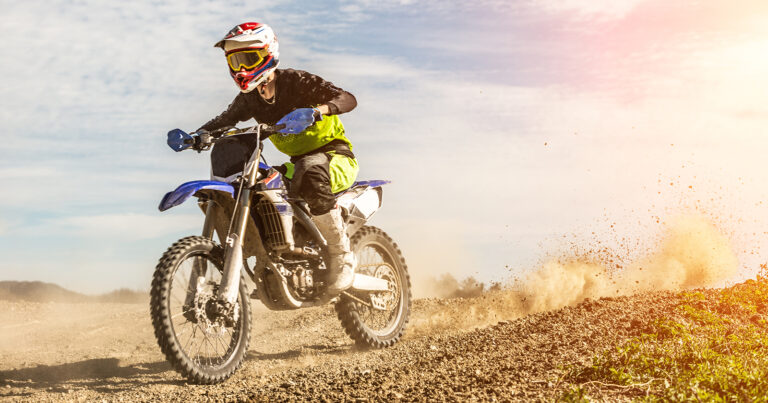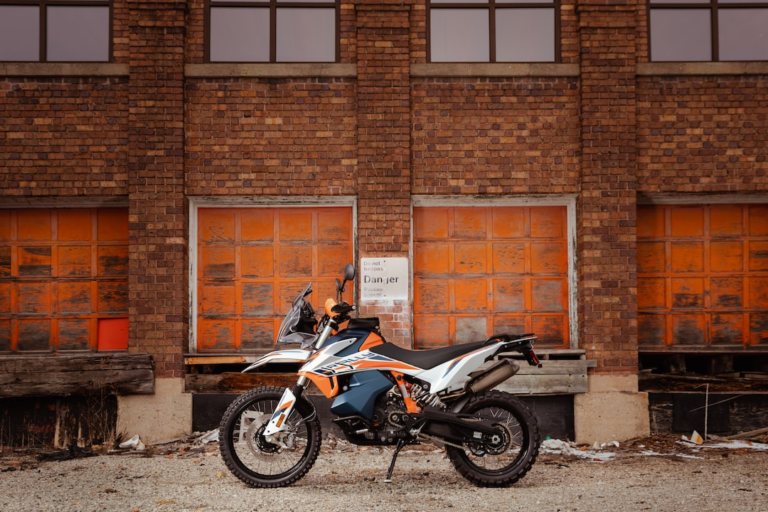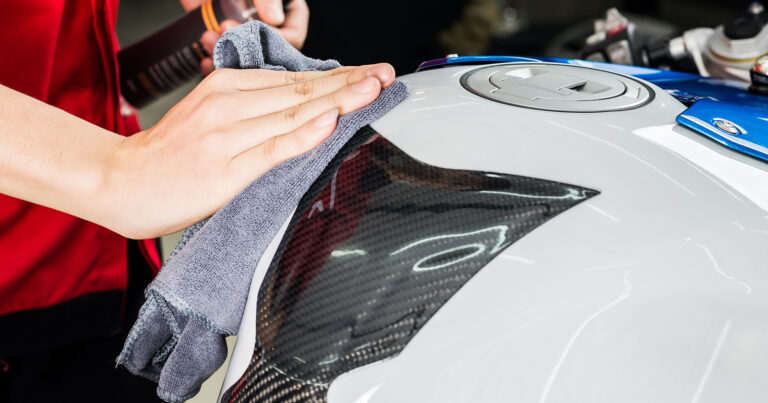What Is An Enduro Motorcycle?
This post may contain affiliate links. That means if you click and buy, we may receive a small commission (at zero cost to you). Please see our full disclosure policy for details.
Picture yourself navigating a narrow, rocky trail, heart pounding as your enduro motorcycle effortlessly tackles each obstacle.
This is the exhilarating world of enduro riding, where every twist and turn offers a new challenge and the thrill of conquering the wild keeps riders coming back for more.
Enduro motorcycles have evolved from their humble beginnings to become cutting-edge machines.
This article delves into their rich history, examines the technological advancements that have revolutionized their design, highlights the contributions of key manufacturers, explores the competitive scene that drives innovation, and forecasts future trends shaping the next generation of enduro biking.
What is an Enduro Bike
An enduro motorcycle is a type of off-road bike designed for long-distance off road adventures on a variety of terrains, including trails, dirt paths, and rugged landscapes, more advanced and more comfortable then dirt bikes.
The term “enduro” comes from the endurance required to participate in the long-distance events for which these motorcycles are often used.
Here are some key characteristics of enduro motorcycle:
Versatility: Enduro bikes are built to handle a mix of off-road conditions, including rocks, mud, sand, and gravel, as well as some on-road riding.
They are often street-legal, equipped with headlights, taillights, mirrors, and indicators.
Suspension: They have long-travel suspension systems to absorb the impact of rough terrain, providing comfort and control over bumps, jumps, and uneven surfaces.
Engine: Enduro bikes typically have engines that are tuned for torque and low-end power to provide better control and manoeuvrability at low speeds.
They come in various engine sizes, ranging from small (125cc) to large (650cc and above).
Weight: These bikes are relatively lightweight compared to other motorcycles, such as dual-sport or adventure bikes, which makes them easier to handle in off-road situations.
Tires: Enduro motorcycle is equipped with knobby tires that offer better grip and traction on loose or uneven surfaces.
Fuel Capacity: They often have larger gas tank compared to motocross bikes to accommodate the long distances travelled during enduro events.
Durability: Built to withstand harsh conditions, enduro bikes have reinforced frames and components to handle the stresses of off-road riding.

A brief history of Enduro Bikes
Early Beginnings (Pre-World War II)1900s-1930s
The concept of enduro motorcycle began with long-distance off-road trials and enduro race. Early motorcycles were primarily modified road bikes, adapted to tackle rough terrains.
Events like the International Six Days Trial (ISDT), established in 1913, played a significant role in popularizing off-road endurance racing.
Post-World War II (1940s-1950s)
1940s: The end of World War II saw a surge in motorcycle manufacturing and innovation. Military motorcycles, used during the war, influenced the design of post-war off-road bikes, leading to more rugged and durable machines.
1950s: Manufacturers such as BSA, Triumph, and Matchless began producing motorcycles specifically designed for off-road use.
The popularity of the ISDT continued to grow, further cementing the demand for specialized enduro motorcycles.
The Rise of Specialized Enduro Bikes (1960s-1970s)
1960s: This decade marked significant advancements in motorcycle technology. Japanese manufacturers like Yamaha, Suzuki, and Honda entered the off-road market, bringing innovations in lightweight design and two-stroke engines.
These developments made motorcycles more agile and better suited for enduro racing.
1970s: The term “enduro” became more widely recognized. This period saw the introduction of bikes specifically marketed as enduro motorcycles, equipped with features like long-travel suspension, knobby tires, and enhanced durability.
The Yamaha DT-1, introduced in 1968, is often credited as one of the first true enduro bikes.

Growth and Evolution of Enduro Motorcycles (1980s-1990s)
1980s: The enduro motorcycle segment continued to evolve with advancements in suspension technology, engine performance, and ergonomics.
European manufacturers like KTM and Husqvarna emerged as leading enduro motorcycle manufacturers, focusing on high-performance off-road bikes.
1990s: This decade saw the refinement of enduro motorcycle, with increased emphasis on lightweight materials and improved handling.
The advent of liquid-cooled engines and more advanced suspension systems further enhanced the capabilities of enduro bikes.
Modern Era
2000s: Enduro motorcycles continued to benefit from technological advancements, including electronic fuel injection, advanced braking systems, and improved materials.
Manufacturers began offering a wider range of models to cater to different skill levels and riding styles.
2010s-Present: The modern enduro motorcycle is a highly specialized machine, designed for both competitive racing and recreational use.
Innovations such as traction control, ride-by-wire systems, and advanced suspension tuning have further refined their performance.
The rise of electric enduro motorcycle, such as those from KTM and Zero Motorcycles, signifies the ongoing evolution of the segment.
Performance Enhancements on Enduro Bike
Advanced Engine Tuning and Management
Modern enduro motorcycle benefits from sophisticated engine tuning and management systems.
These systems optimize fuel injection and ignition timing to maximize power output and efficiency.
Features such as ride-by-wire throttles provide precise control over the engine’s power delivery, ensuring smooth and responsive acceleration across varying off road terrains.

High-Performance Exhaust Systems
Upgraded exhaust systems play a crucial role in enhancing the performance of enduro motorcycles.
High-performance exhausts are designed to improve airflow, reduce weight, and increase horsepower.
These systems often include features such as tuned headers and advanced muffler designs, which not only boost performance but also comply with noise and emissions regulations.
Superior Suspension Technology
The suspension system is a critical component in enduro motorcycles, directly impacting handling and comfort. Performance enhancements in this area include:
- Adjustable Suspension: Allows riders to customize settings for different terrains and riding styles.
- Progressive Springs: Provide a smooth ride over small bumps while maintaining stability on larger impacts.
- High-Performance Dampers: Offer precise control and stability, reducing fatigue and improving handling in rough conditions.
Lightweight and Robust Materials
The use of advanced materials has significantly enhanced the performance of enduro motorcycles.
Components made from high-strength aluminium alloys, carbon fibre, and titanium reduce the bike’s weight while increasing its durability and resistance to damage.
A lighter bike is more agile and easier to control, especially on technical trails and steep inclines.
Cutting-Edge Braking Systems
Braking performance is crucial in enduro riding, where quick stops and precise control are often necessary. Enhanced braking systems of enduro bikes tend to include:
- High-Performance Disc Brakes: Provide superior stopping power and heat dissipation.
- ABS (Anti-lock Braking System): Prevents wheel lock-up during sudden braking, maintaining stability and control.
- Cornering ABS: Adjusts braking force based on the bike’s lean angle, ensuring safe braking even in corners.
Advanced Tire Technology
Tires are a fundamental aspect of an enduro motorcycle’s performance. Modern advancements include:
- Multi-Compound Treads: Offer excellent grip and durability across a variety of surfaces.
- Knobby Tire Designs: Provide superior traction in mud, sand, and rocky terrain.
- Tubeless Options: Reduce the risk of punctures and improve overall handling.
Electronic Aids and Rider Assistance
The integration of electronic systems has brought significant performance enhancements to enduro motorcycles:
- Traction Control: Helps maintain grip on slippery surfaces by modulating power delivery.
- Multiple Riding Modes: Allow riders to select pre-configured settings for different conditions, such as rain, mud, or rocks.
- Quick Shifters: Enable faster gear changes without the need for a clutch, maintaining momentum and reducing rider fatigue.
Ergonomic Improvements
Performance is not solely about speed and power; rider comfort and control are equally important. Enhancements in ergonomics include:
- Adjustable Handlebars and Foot Pegs: Allow customization for rider comfort and control.
- Improved Seat Designs: Provide better support and comfort for long rides.
- Handlebar Controls: Intuitively placed controls for easy access and operation.
Sustainability and the Rise of Electric Enduro Bike
As environmental concerns become more pressing, the motorcycle industry is increasingly focusing on sustainability.
This shift is particularly evident in the development and rise of electric enduro motorcycles, which promise to reduce the environmental footprint of off-road riding without compromising on performance and excitement.
Environmental Impact of Traditional Enduro Bike
Traditional enduro motorcycles, powered by internal combustion engines (ICEs), have long been criticized for their environmental impact. Key issues include:
- Carbon Emissions: ICEs produce significant amounts of CO2, contributing to global warming and climate change.
- Air Pollution: These engines emit harmful pollutants such as nitrogen oxides (NOx) and particulate matter (PM), which degrade air quality and harm human health.
- Noise Pollution: The loud noise generated by ICEs can disturb wildlife and contribute to noise pollution, particularly in natural settings where enduro riding often takes place.
The Shift Towards Electric Enduro Bike
The adoption of electric technology addresses many of the environmental concerns associated with traditional motorcycles:
- Zero Emissions: Electric motorcycles produce no tailpipe emissions, drastically reducing their carbon footprint and helping to combat climate change.
- Reduced Air Pollution: By eliminating the combustion process, electric bikes do not emit harmful pollutants, contributing to cleaner air.
- Quieter Operation: Electric motors operate much more quietly than ICEs, minimizing noise pollution and reducing the disturbance to wildlife and natural environments.
Technological Advancements in Electric Enduro Bike
Several technological advancements have made electric enduro motorcycles a viable and attractive option for riders:
- Battery Technology: Improvements in lithium-ion batteries have increased energy density, allowing electric motorcycles to achieve longer ranges and faster charging times.
- Some models now offer ranges comparable to those of traditional enduro bikes.
- Electric Motors: High-performance electric motors provide instant torque, delivering strong acceleration and smooth power delivery.
- This makes electric enduro motorcycles highly responsive and capable of tackling challenging terrains.
- Regenerative Braking: This technology allows electric motorcycles to recover energy during braking, extending their range and improving efficiency.
The Future of Enduro Motorcycles
The future of enduro motorcycles is poised for significant transformation driven by technological innovation, environmental sustainability, and changing rider preferences. Key developments include:
- Electric and Hybrid Technology: Advances in battery range, rapid charging, and hybrid systems will make electric enduro motorcycles more practical and environmentally friendly.
- Advanced Materials: The use of carbon fibre, composites, and 3D printing will result in lighter, more durable bikes with enhanced performance.
- Smart Technology and Connectivity: Integration of advanced rider assistance systems, connectivity features, and telematics will improve safety and provide real-time data and navigation tools.
- Enhanced Suspension and Handling: Electronically adjustable and active suspension systems will optimize ride quality and control across various terrains.
- Sustainable Manufacturing: Focus on recyclable materials and eco-friendly production processes will reduce the environmental impact of enduro motorcycles.
- Customization and Personalization: Modular components and personalized performance settings will allow riders to tailor their bikes to their specific needs and preferences.
- Electric Enduro Competitions: The rise of electric racing series and increased participation will drive further innovation and broaden the appeal of enduro racing.
- Global Expansion: Greater availability and affordability of enduro motorcycles, along with expanded international events, will foster a diverse and growing community of riders.
Top 5 brands of Enduro Motorcycle.
For 2024, several enduro motorcycle brands are standing out for their quality, performance, and innovation. Here are some of the top brands to consider:
KTM: KTM continues to lead with its 2024 enduro lineup, featuring both two-stroke and four-stroke models. They have revamped their entire range, boasting 95% new components including a new frame, suspension, and bodywork designed for better stability and rider comfort.
Notable models include the 350 EXC-F and 500 EXC-F, which are street legal in the U.S.

Husqvarna: As a subsidiary of KTM, Husqvarna offers similar high-performance enduro motorcycles with a focus on versatility and comfort.
The FE 501s is a standout model, praised for its smooth acceleration, flexible handling, and compliance with street-legal requirements. It’s a great choice for both unpaved roads and road use.
Beta: This Italian manufacturer has been making waves with its enduro bikes, which are known for their light weight design and powerful performance.
The Beta 500 RR-S is particularly noted for its adjustability and smooth power delivery, making it suitable for a wide range of riders.

Sherco: Known for their robust and reliable bikes, Sherco offers models like the SE Factory series, which include both two-stroke (SE) and four-stroke (SEF) variants.
These bikes are tailored for competitive and technical natural terrain, providing excellent handling and durability.

Yamaha: The Yamaha TW 200, while more of a dual-sport than a pure enduro, remains a popular choice for its simplicity, durability, and ease of use.
It’s particularly well-suited for beginners and those looking for a reliable bike for both technical terrain and casual on road riding.

Frequently Asked Questions About Enduro Motorcycles
How is an enduro motorcycle different from a motocross bike?
While both are off-road motorcycles, enduro bikes are designed for endurance and versatility, featuring larger fuel tanks, softer suspension for comfort over long distances, and street legal equipment.
Motocross bikes, on the other hand, are built for short, high-intensity track racing with stiff suspension and lighter weight.
Are enduro motorcycles street legal?
Many enduro motorcycles are street- legal, equipped with necessary features such as headlights, taillights, mirrors, indicators, as well insurance to comply with road regulations. However, it depends on the specific model and local laws to ensure they are are legal for street riding.
What engine sizes are common in enduro motorcycles?
Enduro motorcycles come in various engine sizes, typically ranging from 125cc to 650cc and above.
Smaller engines are more suitable for technical and tight trails, while larger engines provide more power for open trails, dirt roads and faster riding.
How should I maintain my enduro motorcycle?
Regular maintenance includes checking and changing the oil, cleaning or replacing the air filter, inspecting and adjusting the chain, checking tire pressure and condition, and ensuring all bolts and fasteners are secure.
Additionally, suspension and brake systems should be periodically inspected and serviced.
Can beginners ride enduro motorcycles?
Yes, beginners can ride enduro motorcycles, but it’s important to choose a bike that matches your skill level.
Smaller, less powerful models are more manageable for new riders. Taking a training course through an american motorcycle association or your local motorcycle club can also help build confidence and skills.
Conclusion
Enduro motorcycles epitomize the thrilling blend of tradition and innovation, capturing the essence of endurance and versatility in off-road riding.
Their evolution from modified road bikes to highly specialized machines showcases a commitment to performance, durability, and rider comfort.
The enduring appeal of enduro motorcycle lies in their ability to navigate the most rough terrain while providing a thrilling and rewarding experience.
As technology continues to advance, enduro motorcycle is poised to become even more sophisticated.
The integration of electronic systems, enhanced suspension technologies, and environmentally friendly electric models signifies a future where performance meets sustainability.
With the growing popularity of extreme enduro races and a diverse range of models catering to various skill levels, the enduro motorcycle community is expanding, attracting both seasoned riders and newcomers.
Read more:
- Guide to the 10 Best Motorcycle Sunglasses
- 10 Best Heated Motorcycle Gloves
- Understanding CC in Motorbikes: What Does it Mean?
- 6 Best Bar End Mirrors for Motorcycles












